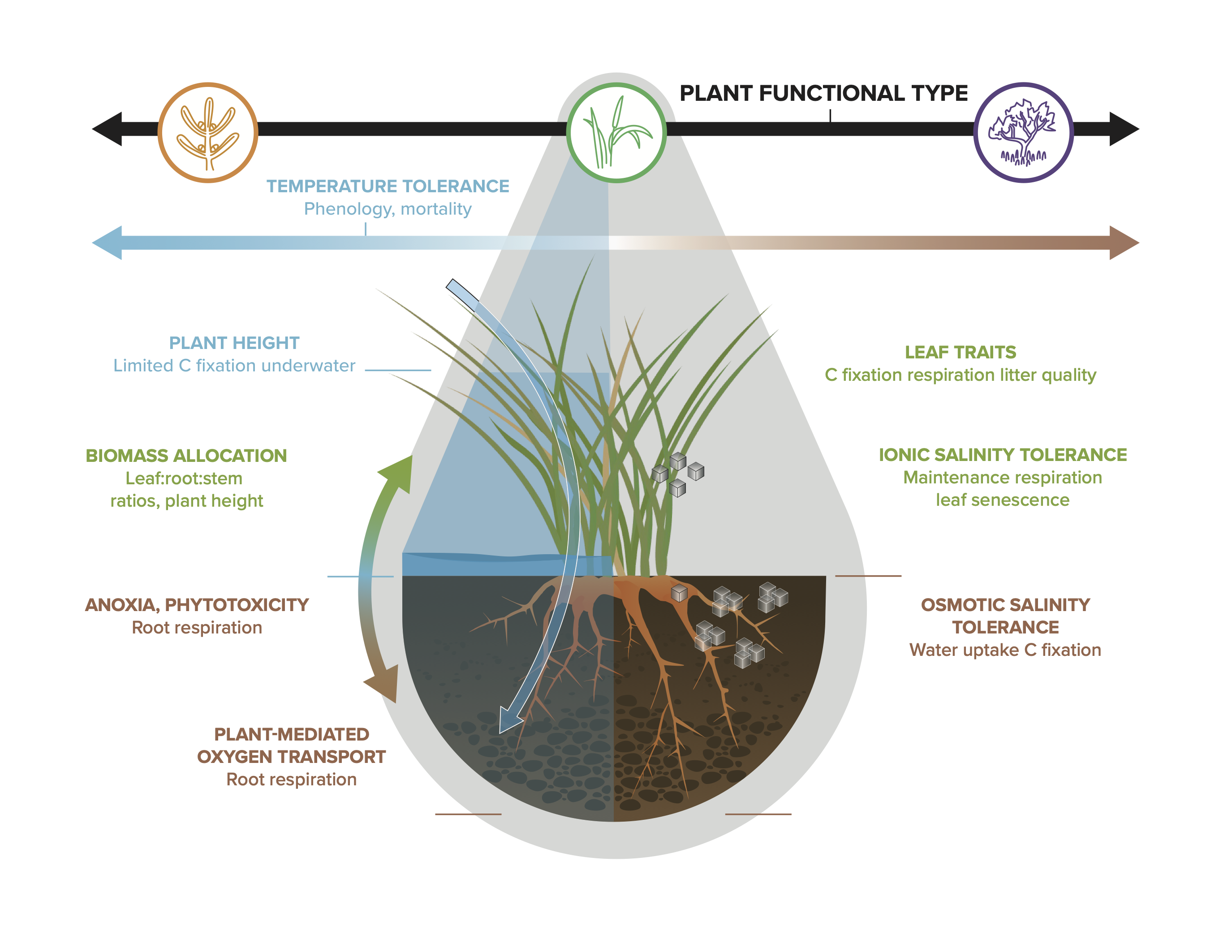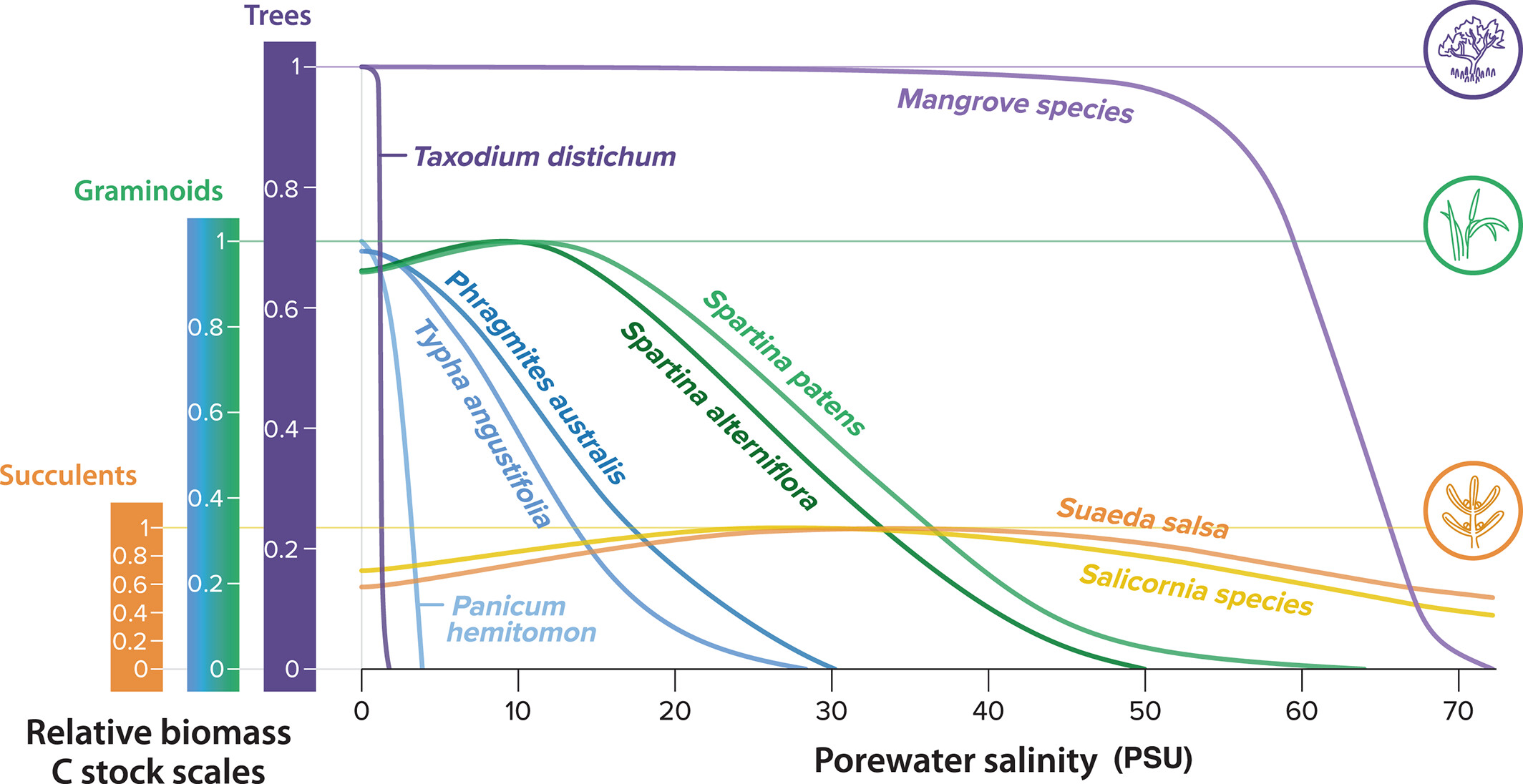A Roadmap for Improving Models of Coastal Wetland Vegetation
Incorporating coastal vegetation types and their tolerances to salinity and flooding can improve land models.
The Science
Coastal wetlands are subject to fluctuations in salinity and water levels and are home to specialized plant species that can sequester carbon at high rates. This study synthesized information about plant types and environmental controls in coastal wetlands and suggests that including specific vegetation types (salt marsh, mangrove, and succulent, see Fig. 1) and their different responses to salinity (Fig 2.) and water levels can improve land model simulations of carbon storage and greenhouse gas balance of coastal regions.

Figure 1. Diagram showing important coastal wetland plant traits including height, biomass allocation, anoxia, plant-mediated oxygen transport, leaf traits, ionic salinity tolerance, osmotic salinity tolerance, and temperature tolerance that should be implemented in land surface models for better representation of coastal wetland vegetation processes. The downward-pointing blue arrow represents plant-mediated oxygen transport. The horizontal blue and red arrows represent the spectrum of plant functional types adapted to different climates.
The Impact
Coastal wetland ecosystems can store carbon at very high rates but are not well represented in current land models, which can lead to model simulations’ underestimation of ecosystem carbon sequestration in coastal regions. Improving how coastal vegetation is simulated in these models is an important step toward improved predictions of coastal wetland carbon sequestration and other ecosystem services, as well as the vulnerability of coastal wetlands to sea level rise and other stressors.

Figure 2. A qualitative comparison of biomass carbon (C) between coastal plant functional types (succulents, graminoids, trees), and within plant functional types as a function of porewater salinity (practical salinity units, PSU). Estimated changes in biomass carbon with increasing salinity are synthesized from the literature, see paper for details.
Summary
Coastal wetlands are poorly represented in land surface models, even though these ecosystems can sequester carbon at very high rates. Incorporating coastal wetland vegetation into land models could therefore improve simulations of carbon sequestration and related ecosystem services in coastal regions. This study identifies guiding questions, simulation strategies, and data needs for improving model representation of vegetation in coastal and estuarine ecosystems. Models could improve the representation of coastal wetlands by including separate plant functional types for mangroves, graminoid salt marshes, and succulent salt marshes to adequately represent the variations in productivity as well as above- and below-ground partitioning of biomass across vegetation types. Coastal vegetation types also represent a broad range of tolerances and adaptations to fluctuations in salinity and water level, which drive key gradients in coastal wetland ecosystems. Shifts in dominant plant functional types driven by shifts in water levels, climate, and salinity could have significant consequences for carbon storage due to the substantial differences in biomass and growth patterns across coastal wetland plant types.
Publication
- LaFond‐Hudson, Sophia, and Benjamin N Sulman. 2023. “Modeling Strategies And Data Needs For Representing Coastal Wetland Vegetation In Land Surface Models”. New Phytologist. Wiley. doi:10.1111/nph.18760.
Funding
-
This work was supported by the Earth System Model Development program area of the Department of Energy, Office of Science, Biological and Environmental Research program via the Office of Science Early Career Research Program Award.
Contact
- Benjamin Sulman, Oak Ridge National Laboratory
This article is a part of the E3SM “Floating Points” Newsletter, to read the full Newsletter check:


